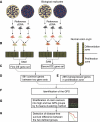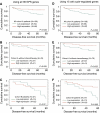Reduced expression of a gene proliferation signature is associated with enhanced malignancy in colon cancer
- PMID: 19238634
- PMCID: PMC2538751
- DOI: 10.1038/sj.bjc.6604560
Reduced expression of a gene proliferation signature is associated with enhanced malignancy in colon cancer
Abstract
The association between cell proliferation and the malignant potential of colon cancer is not well understood. Here, we evaluated this association using a colon-specific gene proliferation signature (GPS). The GPS was derived by combining gene expression data obtained from the analysis of a cancer cell line model and a published colon crypt profile. The GPS was overexpressed in both actively cycling cells in vitro and the proliferate compartment of colon crypts. K-means clustering was used to independantly stratify two cohorts of colon tumours into two groups with high and low GPS expression. Notably, we observed a significant association between reduced GPS expression and an increased likelihood of recurrence (P < 0.05), leading to shorter disease-free survival in both cohorts. This finding was not a result of methodological bias as we verified the well-established association between breast cancer malignancy and increased proliferation, by applying our GPS to public breast cancer data. In this study, we show that reduced proliferation is a biological feature characterizing the majority of aggressive colon cancers. This contrasts with many other carcinomas such as breast cancer. Investigating the reasons underlying this unusual observation may provide important insight into the biology of colon cancer progression and putative novel therapy options.
Figures



References
-
- Allegra CJ, Paik S, Colangelo LH, Parr AL, Kirsch I, Kim G, Klein P, Johnston PG, Wolmark N, Wieand HS (2003) Prognostic value of thymidylate synthase, Ki-67, and p53 in patients with dukes' B and C colon cancer: a National Cancer Institute-national surgical adjuvant breast and bowel project collaborative study. J Clin Oncol 21: 241–250 - PubMed
-
- Chung CH, Parker JS, Karaca G, Wu J, Funkhouser WK, Moore D, Butterfoss D, Xiang D, Zanation A, Yin X (2004) Molecular classification of head and neck squamous cell carcinomas using patterns of gene expression. Cancer Cell 5: 489–500 - PubMed
-
- Colantuoni C, Henry G, Zeger S, Pevsner J (2002) SNOMAD (Standardization and NOrmalization of MicroArray Data): web-accessible gene expression data analysis. Bioinformatics 18: 1540–1541 - PubMed
Publication types
MeSH terms
Substances
LinkOut - more resources
Full Text Sources
Other Literature Sources

